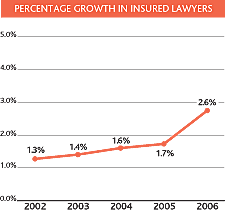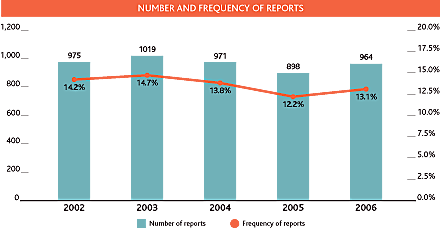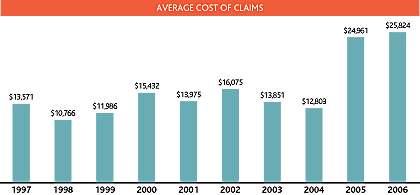This Insurance Issues:
- reports on the 2007 insurance program and policy
- reviews statistics on claims and potential claims (negligence and theft)
- highlights website resources
- announces a seminal risk management publication on missed deadlines
The Lawyers Insurance Fund (LIF) manages the Law Society’s insurance program for BC lawyers. The program provides:
- professional liability insurance to protect lawyers if they are liable for negligence and to ensure that clients receive compensation to which they are entitled (Part A of the policy); and
- trust protection coverage to ensure that innocent members of the public do not suffer a financial loss through theft by a BC lawyer (Part B of the policy).
Assessment
After seven consecutive years at $1,500, the annual assessment for Part A professional liability insurance was reduced this year to $1,400. This assessment is the lowest since 1986 and represents a significant reduction from the high of $2,600 that was assessed in 1990 (and for half of the current coverage). This further reduction is the result of a stable loss experience and effective claims management by the Lawyers Insurance Fund. However, this assessment will continue to reduce the Fund surplus, and may not be sustainable in the long term.
No fee will be charged for Part B trust protection coverage in 2007.
Compulsory policy wording
A consolidated policy was issued for 2007. The 2007 policy incorporates changes to the wording made by endorsement in 2005 and 2006, as well as the following:
Part A (professional liability insurance)
Changes of a housekeeping nature are made to three provisions in Part A.
In the declarations, the description of the deductible is revised by removing the words “which give rise to claims” as part of the reference to “error.” These words were unnecessary. In addition, the words “including damages, claims expenses and deductibles” are moved from the general description of the limits of liability to each of the particular limits for Part A. The revisions do not affect either the deductible or the limits.
The definition of “damages” is revised by replacing the words “monetary award” with “compensatory damages.” Paragraph (i) of the definition is revised slightly, as follows:
Damages does not include:
(i) an order of set-off or any order for the return or reimbursement of, or accounting for or disgorgement of, any property, benefit, legal fees or disbursements that you received, even if claimed as general damages;
The revisions clarify that the policy does not respond to claims for payment of a benefit obtained by a lawyer, whether that benefit was received from the claimant or a third party.
Condition 2.3 is amended by adding the words “law firms or Individual Insureds.” Negligence claims may be made against lawyers at separate firms. The amendment clarifies that the deductible is triggered for each separate firm, even if the claim names only the individual lawyer and not the firm.
Part B (trust protection coverage)
As reported in the November–December 2006 Benchers’ Bulletin, the Benchers approved two amendments effective January 1, 2007. The first clarifies that Part B does not apply to losses resulting from investments made through lawyers, unless a lawyer misappropriates the funds directly. The second limits recoveries to $300,000 per claim (see below). These changes are introduced through various revisions made to the declarations, exclusions and conditions for Part B. For more information, see “Benchers clarify Trust Protection Coverage,” Benchers’ Bulletin No. 5 (November–December 2006). In addition, the definition of “error” for Part B is revised to clarify that Part B is not intended to respond to personal loans made to lawyers.
A copy of the 2007 consolidated policy is enclosed in this mailing. Consolidated policies issued beginning in 2000, and subsequent endorsements, are available in the Lawyers Insurance Fund section of the Law Society’s website (www.lawsociety.bc.ca).
Coverage under the 2006 compulsory policy
The limits of coverage remain unchanged for Part A. Additional limits for Part B are introduced.
Part A (professional liability insurance)
The policy continues to provide each insured lawyer with $1 million of coverage for each error, to an annual maximum of $2 million for all errors reported during the year. The deductible remains at $5,000 for a paid claim, increasing to $10,000 for each subsequent paid claim reported within three years.
The limits offer sufficient financial protection for the majority of claims faced by lawyers. However, if a claim exceeds the limits provided by the primary policy, any lawyers responsible are personally exposed to an excess judgment. The adequacy of the primary limits depends, in part, on the nature of a lawyer’s own activities, as well as those of partners, associates and employees and the potential impact of those activities, in a worst-case scenario, on clients and third parties. Excess insurance extends the limits of coverage offered by the primary policy, and may pick up risks not covered by it. We recommend that all firms consider the financial and “sleep-easy” benefits of the additional protection offered by excess insurance. It is available on the private market. Lawyers should consult a broker experienced in lawyers liability insurance to determine if excess insurance is appropriate for their firm.
Part B (trust protection coverage)
The policy continues to provide a profession-wide aggregate limit of $17.5 million for Law Society members. A new per claim limit of $300,000 is introduced, entitling each claimant to recover up to $300,000 per claim. Although there is no deductible, lawyers are obliged to reimburse the insurer in full for any paid claims.
A review of claim and potential claim reports
Part A (professional liability insurance)
The program’s continuing stability is illustrated by the charts on pages 2-4. 2006 saw a moderate increase in the number of insured lawyers, as well as the number of reports. Although case reserves showed an increase in both 2005 and 2006, the average cost of claims is based on LIF estimates, and tends to decrease over time as more information becomes available. Changes in the average cost of claims over the past 10 years still remain gradual, suggesting that significant developments are unlikely.
The chart Percentage growth in insured lawyers shows the percentage growth over the past five years. Insured lawyers include both full and part-time lawyers and reports include both claims and potential claims.

The chart Number and frequency of reports shows the number of reports and the frequency of reports (reports divided by insured lawyers) over the past five years.

The chart Average cost of claims shows the average cost per report over the last 10 years.

Part B (trust protection coverage)
Trust protection coverage was introduced on May 1, 2004. Since then, the program’s claims experience has reflected that of the Law Society’s historically: only a very small number of lawyers are involved in actual misappropriations.
In 2006, there were 34 new reports of claims and potential claims against 17 lawyers, six of whom also had reports opened in 2004 or 2005. This compares with 24 reports of claims and potential claims against 18 lawyers in 2004 and 2005. In 2006:
- Three claims were paid on behalf of different lawyers, totalling approximately $6,300. In the first, a lawyer paid himself a sum of money from his trust account, in an apparent mistaken belief that he was entitled to the full sum. In fact, he was only entitled to a portion of those funds, and the withdrawal resulted in a shortfall to the claimants. In the second, the lawyer was retained to probate an estate. An interim account was paid, and a further retainer provided. The lawyer withdrew the retainer funds from trust, although no account was rendered nor work done to justify the withdrawal. In the third, the lawyer received funds to pay an expert for a report that assisted in the defence of the lawyer’s client. Rather than paying the expert, the lawyer kept the funds. None of the lawyers involved remain as members of the Law Society, and all are obliged to reimburse the Law Society for the amounts paid on their behalf.
- Three claims were withdrawn or abandoned by claimants.
- Two matters reported as potential claims did not develop into claims.
- Three claims did not fall within the terms of coverage for Part B. In these claims, the lawyers did not misappropriate property and no payments were made. Claimants have full recourse to the Courts if they do not agree with the result.
The remaining reports consist of situations in which the claimant is not actively pursuing a Part B claim, or the claim is being pursued but we are not yet in a position to determine if it is properly payable. For instance, on some matters we must wait until the conclusion of the discipline process to complete our assessment of the Part B claim.
For a full description of Part B trust protection coverage, including claims management and coverage, please see Insurance Issues No. 2 May–June 2004. Frequently asked questions designed specifically for the public are available on the Lawyers Insurance Fund’s section of the Law Society’s website.
Lawyers Insurance Fund “in a class by itself” — results of the 2006 claims audit
Every three years, an independent claims audit is conducted by auditors experienced in professional liability claims. The audit helps determine whether the Lawyers Insurance Fund is meeting its objective of managing claims in a cost-effective manner, balancing the interests of the public, members of the profession and the Law Society. In the 2003 report, the auditors from Crawford Adjusters Canada concluded that: The Lawyers Insurance Fund has attained a level of quality and consistency that should be the envy of the insurance industry.
The 2006 claims audit was conducted by the Montreal law firm of Nicholl Paskell-Mede, a firm selected by the Audit Committee for its coverage expertise and experience in defending lawyers malpractice claims. The firm has conducted numerous claims audits of professional liability programs, including audits of Ontario’s lawyers insurance program. In the 2006 audit report delivered to the Benchers in December, the auditors find that: … the Lawyers Insurance Fund is in a class of its own among Bar mutual organizations ... the level of professionalism and sense of mission achieved by staff (LIF claims counsel) remains unique.
As in previous years, the claims audit included a formal file audit of a random selection of a proportionate representation of open and closed files, and a detailed evaluation of internal documentation. The auditors reported that the Lawyers Insurance Fund meets its mandate, and that:
- strong and effective management brings a degree of continuity and focus that has a tangible positive impact on the daily management of claims and demonstrates professionalism, skill and sound judgement that are invaluable to the profession;
- staff give careful consideration in good faith to all claims, and consistently “take the high road” in approaching both coverage and liability issues; and
- staff are candid, considerate and professional in their dealings with insured lawyers, and the relationships between them are excellent.
Various claims management practices were singled out for specific comment and endorsement by the auditors:
- the Law Society’s policy of keeping claims information confidential from its disciplinary arm is “as it should be,” as it would be wrong for the trust relationship established in the context of a claim to be used to collect information for other purposes. The policy also ensures that any impediment to the frank discussion of claims necessary for effective claim repair and resolution is avoided.
- the quality of outside counsel is very good, and the use of a restricted number of firms focuses experience and maintains productive and trusting professional relationships.
- proactive management of files and imagination in resolving and repairing claims is key to LIF’s overall success, with repeated instances of creative solutions brought to fruition at little or no cost to the program.
- in defending files in-house – a practice virtually unique among law society insurers in Canada – staff are highly competent and appropriately aggressive, and the practice represents a significant cost savings to the members.
The auditors also noted that the low turnover in staff, for positions that are challenging, complex and highly skilled, makes the Lawyers Insurance Fund a very effective organization, and concluded by stating: In our opinion, the Lawyers Insurance Fund is doing an excellent job, even by its own high standards.
LIF exceptional service continues
The Lawyers Insurance Fund continues to achieve high service ratings from insured lawyers. A service evaluation form is sent out to each insured lawyer at the time a file is closed. The lawyer is asked to rate his or her satisfaction on a scale of 1 (“not at all”) to 5 (“a lot”) in a number of areas relating to program performance. We also specifically ask for comments, both positive (“kudos”) and negative (“grumbles”), regarding the services provided. These comments can provide valuable information that assist the Lawyers Insurance Fund in planning improvements in service. Whenever an insured lawyer has a negative comment, we follow up to determine how best to address the concern expressed.
The return rate is excellent (almost 60%), and BC lawyers continue to express high satisfaction overall with these services. In 2006, 95% of survey respondents gave a high approval rating (4 or 5 on a scale of 1 to 5) on the services provided by defence counsel, 93% on the outcome of their claims, 95% on the handling of their claims and 96% on the services provided by LIF Claims Counsel.
Website resources
If you’re not familiar with the Lawyers Insurance Fund section of the Law Society’s website (www.lawsociety.bc.ca), take a moment to visit. Select “Regulation & Insurance,” “Insurance” and then “Overview.” A tremendous amount of information is available about the insurance program through various links:
- Insurance Policies – summarizes coverage under the compulsory and optional policies, explains how to report a claim and includes the policies;
- Reporting Guidelines – sets out the exact information required in reporting a claim or potential claim;
- Coverage Enquiries & Rulings – answers frequently asked questions about whether an activity or practice in certain circumstances is covered by the policy. The questions answered relate to insurance coverage for lawyers no longer in private practice or acting either as trustees or executors, or mediators or arbitrators, and for services provided pro bono or outside of BC. The policy’s business and benefit exclusion is also explained.
- Insurance Issues: Program Reports – provides this report, issued each year in conjunction with a new policy. The publication reports on the program and policy for the upcoming year, claims and potential claims from the past year, and issues in the insurance program relevant to members.
- New Initiatives – explains the insurance impact of recent initiatives the Law Society has embarked upon that are developed or supported by the Lawyers Insurance Fund. These initiatives include the national mobility regime, participation in the compulsory insurance program by public service lawyers and free insurance coverage for lawyers, not otherwise insured, for certain pro bono services. There is also information on solicitor property sales and the Western Law Societies Conveyancing Protocol.
- Lawyers Insurance Fund Staff – offers a contact list with the names, direct numbers and e-mail addresses of all Claims Counsel, as well as their areas of expertise.
- Risk Management – provides links to Insurance Issues: Risk Management, as well as Alert! bulletins issued to alert the profession to critical issues that present immediate risk to lawyers. Risk Management publications available are:
- Curbing risk in real estate practice – focuses on e-filing in the Land Title Office and keeping copies of picture identification as two useful risk management tools, and offers advice on managing instructions from lenders.
- About to act for family and friends? (Resist — it’s just too risky) – sets out the often unfortunate consequences for lawyers acting for family or friends and the increased risk of making a mistake or facing an insurance claim.
- “Real estate fraud – a prevention primer” – offers lawyers concrete practice tips to help recognize and manage the risk of unwittingly becoming a pawn in a real estate value or identity fraud.
This page also contains a section dedicated to fraud prevention. In 2005, the Benchers amended Chapter 4, Rule 6 of the Professional Conduct Handbook to reinforce a lawyer’s duty to be on guard against becoming the tool or dupe of an unscrupulous client. To help lawyers recognize and manage this risk, the Lawyers Insurance Fund and the Law Society have produced a number of information pieces on fraudulent schemes, and links to all of these are available on the website.
2007 and beyond — and a New Year’s resolution to Beat the Clock
The profession as a whole can have confidence in the Lawyers Insurance Fund’s ability to effectively manage claims for the protection of lawyers, the profession and the public. However, careful practice and effective risk management remain the most effective means of ensuring continued stability in both the program’s costs and your annual insurance fee.
As one in every four reports to the Lawyers Insurance Fund is the result of a missed limitation or other deadline, we suggest that you make the following resolution for the New Year: I will not miss a deadline or limitation in 2007or ever (or ever again). To support you in keeping this resolution, the Lawyers Insurance Fund is publishing Beat the clock, a comprehensive booklet with practical tips to help you avoid missing deadlines and limitations. It will be available online, and hard copies will be mailed to all lawyers in private practice. Stay tuned.